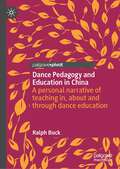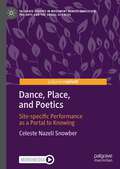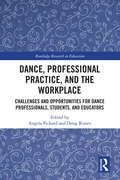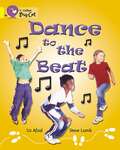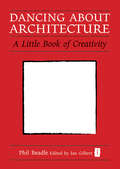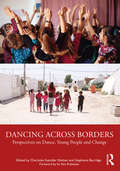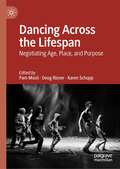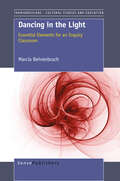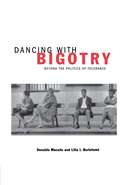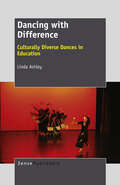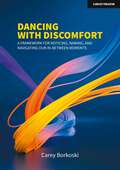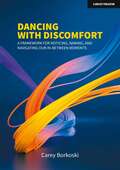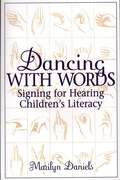- Table View
- List View
Dance Pedagogy
by Amanda ClarkDance Pedagogy is a comprehensive resource designed for dance students and teaching artists to develop skills and strategies in the multifaceted practice of teaching dance.This invaluable resource features essential components and considerations necessary for the dance teacher in any setting, including the private and community sector, university setting, and professional venues. Five distinct units provide insight into the paradigm, learning process, class environment factors, planning, and delivery of the dance class in a broad context through the use of examples within the dance forms of ballet, jazz, modern, tap, and hip-hop. Readers intently explore cognitive and motor learning, strategies for developing curricula and lesson plans, and methods of delivering material to students. Basic principles of anatomy, understanding student behavior and participation, the importance of diversity, equity, inclusion and accessibility (IDEA), music concepts for the dancer, injury prevention, and classroom management are included to provide a well-rounded approach to the many challenges faced in the classroom.Dance Pedagogy provides the most holistic approach available in the art of teaching dance and is a core textbook for academic courses related to Dance Teaching Methods as well as an invaluable handbook for practicing dance teachers.
Dance Pedagogy
by Amanda ClarkDance Pedagogy is a comprehensive resource designed for dance students and teaching artists to develop skills and strategies in the multifaceted practice of teaching dance.This invaluable resource features essential components and considerations necessary for the dance teacher in any setting, including the private and community sector, university setting, and professional venues. Five distinct units provide insight into the paradigm, learning process, class environment factors, planning, and delivery of the dance class in a broad context through the use of examples within the dance forms of ballet, jazz, modern, tap, and hip-hop. Readers intently explore cognitive and motor learning, strategies for developing curricula and lesson plans, and methods of delivering material to students. Basic principles of anatomy, understanding student behavior and participation, the importance of diversity, equity, inclusion and accessibility (IDEA), music concepts for the dancer, injury prevention, and classroom management are included to provide a well-rounded approach to the many challenges faced in the classroom.Dance Pedagogy provides the most holistic approach available in the art of teaching dance and is a core textbook for academic courses related to Dance Teaching Methods as well as an invaluable handbook for practicing dance teachers.
Dance Pedagogy and Education in China: A personal narrative of teaching in, about and through dance education
by Ralph BuckThis pivot offers an innovative approach to dance education, bringing a creative and inclusive dance education pedagogy into Chinese dance classrooms. Associate Professor Ralph Buck’s experiences of teaching dance at the Beijing Dance Academy and the possible implications for dance education in China lie at the heart of this text. Through a critical examination of personal teaching practice, pedagogical issues, trends and rationales for dance education in the curriculum are highlighted. Informed by constructivist ideals that recognise dialogue and interaction, this pivot suggests that dance can be re-positioned and valued within educational contexts when pedagogical strategies and objectives are framed in terms of teaching and learning in, about and through dance education.
Dance, Place, and Poetics: Site-specific Performance as a Portal to Knowing (Palgrave Studies in Movement across Education, the Arts and the Social Sciences)
by Celeste Nazeli SnowberThis book explores the relationship between the body, ecology, place, and site-specific performance. The book is situated within arts-based research, particularly within embodied inquiry and poetic inquiry. It explores a theoretical foundation for integration of these areas, primarily to share the lived experiences, poetry and dance which have come out of decades of sharing site-specific performances.
Dance-Play and Drawing-Telling as Semiotic Tools for Young Children’s Learning (Routledge Research in Early Childhood Education)
by Jan Deans Susan WrightInvestigating children’s learning through dance and drawing-telling, Dance-Play and Drawing-Telling as Semiotic Tools for Young Children’s Learning provides a unique insight into how these activities can help children to critically reflect on their own learning. Promoting the concept of dance and drawing-telling as highly effective semiotic tools for meaning-making, the book enlivens thinking about the extraordinary capacities of young children, and argues for the incorporation of dance and drawing in mainstream early childhood curriculum. Throughout the book, numerous practice examples show how children use movement, sound, images, props and language to imaginatively re-conceptualize their everyday experiences into bodily-kinesthetic and spatial-temporal concepts. These examples illustrate children’s competence when given the opportunity to learn through dance and drawing-telling, as well as the important role that teachers play in scaffolding children’s learning. Based on award-winning research, this insightful and informative book makes a sought after contribution to the field of dance education and seeks to reaffirm dance as a powerful learning modality that supports young children’s expressive non-verbal communication. Encouraging the reader to consider the significance of multi-modal teaching and learning, it is essential reading for researchers in the dance, drawing and education spheres; postgraduate students taking courses in early childhood; play and dance therapists; and all early childhood teachers who have a specific interest in arts education.
Dance-Play and Drawing-Telling as Semiotic Tools for Young Children’s Learning (Routledge Research in Early Childhood Education)
by Jan Deans Susan WrightInvestigating children’s learning through dance and drawing-telling, Dance-Play and Drawing-Telling as Semiotic Tools for Young Children’s Learning provides a unique insight into how these activities can help children to critically reflect on their own learning. Promoting the concept of dance and drawing-telling as highly effective semiotic tools for meaning-making, the book enlivens thinking about the extraordinary capacities of young children, and argues for the incorporation of dance and drawing in mainstream early childhood curriculum. Throughout the book, numerous practice examples show how children use movement, sound, images, props and language to imaginatively re-conceptualize their everyday experiences into bodily-kinesthetic and spatial-temporal concepts. These examples illustrate children’s competence when given the opportunity to learn through dance and drawing-telling, as well as the important role that teachers play in scaffolding children’s learning. Based on award-winning research, this insightful and informative book makes a sought after contribution to the field of dance education and seeks to reaffirm dance as a powerful learning modality that supports young children’s expressive non-verbal communication. Encouraging the reader to consider the significance of multi-modal teaching and learning, it is essential reading for researchers in the dance, drawing and education spheres; postgraduate students taking courses in early childhood; play and dance therapists; and all early childhood teachers who have a specific interest in arts education.
Dance, Professional Practice, and the Workplace: Challenges and Opportunities for Dance Professionals, Students, and Educators (Routledge Research in Education)
by Angela Pickard Doug RisnerOriginally published as a special issue of Research in Dance Education, now with an added chapter, this text acknowledges and celebrates the increasingly diverse careers and employment networks in which dance professionals and dance educators are engaged. Addressing issues and developments relating to the workplace of dance, the text explores what it means to transcend the boundary between dance as passion, and dance as employment. Chapters explore challenges of professional practice including limitations on access, precarity, bodily risk, gender inequality, and sexual harassment, and challenge the status quo to offer readers new ways of thinking about dance, and how this might translate into professional practice and work. Ultimately celebrating the passion which motivates dancers to embark on a professional career, and highlighting the elation and joy which such employment can bring, this volume encourages dance professionals, students, and educators to imagine things differently and develop teaching approaches, curricula, work places, and communities which capitalise on the diversity and dedication of individuals in the field. This text will be of great interest to graduate and postgraduate students, researchers, academics, professionals in the field of Dance, Dance Education, Choreography and related art forms, Curriculum studies and Sociology of Education.
Dance, Professional Practice, and the Workplace: Challenges and Opportunities for Dance Professionals, Students, and Educators (Routledge Research in Education)
by Angela Pickard Doug RisnerOriginally published as a special issue of Research in Dance Education, now with an added chapter, this text acknowledges and celebrates the increasingly diverse careers and employment networks in which dance professionals and dance educators are engaged. Addressing issues and developments relating to the workplace of dance, the text explores what it means to transcend the boundary between dance as passion, and dance as employment. Chapters explore challenges of professional practice including limitations on access, precarity, bodily risk, gender inequality, and sexual harassment, and challenge the status quo to offer readers new ways of thinking about dance, and how this might translate into professional practice and work. Ultimately celebrating the passion which motivates dancers to embark on a professional career, and highlighting the elation and joy which such employment can bring, this volume encourages dance professionals, students, and educators to imagine things differently and develop teaching approaches, curricula, work places, and communities which capitalise on the diversity and dedication of individuals in the field. This text will be of great interest to graduate and postgraduate students, researchers, academics, professionals in the field of Dance, Dance Education, Choreography and related art forms, Curriculum studies and Sociology of Education.
Dance To The Beat: Band 03/yellow (Collins Big Cat Ser.)
by Uz Afzal Steve Lumb Cliff Moon Collins Big CatDancing About Architecture: A Little Book of Creativity
by Phil BeadleDancing about Architecture: A Little Book of Creativity is a compendium of outrageous ideas: ideas about how to take more risks, and about how to go about coming up with better ideas. Ideas about how to plan experiences that leave people who are in the same room as those ideas awestruck, and ideas to help you avoid the textbook, the worksheet the barely stifled yawn. From using The Book of Revelation as a planning device; to seeing every experience through the prism of physical activity or song; to measuring a poem to find its real heart; it outlines a methodology that, if you use it, will make you an even greater creative force than you already are.
Dancing Across Borders: Perspectives on Dance, Young People and Change
Dancing Across Borders presents formal and non-formal settings of dance education where initiatives in different countries transcend borders: cultural and national borders, subject borders, professional borders and socio-economic borders. It includes chapters featuring different theoretical perspectives on dance and cultural diversity, alongside case narratives that show these perspectives in a specific cultural setting. In this way, each section charts the processes, change and transformation in the lives of young people through dance. Key themes include how student learning is enhanced by cultural diversity, experiential teaching and learning involving social, cross-cultural and personal dimensions. This conceptually aligns with the current UNESCO protocols that accent empathy, creativity, cooperation, collaboration alongside skills- and knowledge-based learning in an endeavour to create civic mindedness and a more harmonious world. This volume is an invaluable resource for teachers, policy makers, artists and scholars interested in pedagogy, choreography, community dance practice, social and cultural studies, aesthetics and interdisciplinary arts. By understanding the impact of these cross-border collaborative initiatives, readers can better understand, promote and create new ways of thinking and working in the field of dance education for the benefit of new generations.
Dancing Across Borders: Perspectives on Dance, Young People and Change
Dancing Across Borders presents formal and non-formal settings of dance education where initiatives in different countries transcend borders: cultural and national borders, subject borders, professional borders and socio-economic borders. It includes chapters featuring different theoretical perspectives on dance and cultural diversity, alongside case narratives that show these perspectives in a specific cultural setting. In this way, each section charts the processes, change and transformation in the lives of young people through dance. Key themes include how student learning is enhanced by cultural diversity, experiential teaching and learning involving social, cross-cultural and personal dimensions. This conceptually aligns with the current UNESCO protocols that accent empathy, creativity, cooperation, collaboration alongside skills- and knowledge-based learning in an endeavour to create civic mindedness and a more harmonious world. This volume is an invaluable resource for teachers, policy makers, artists and scholars interested in pedagogy, choreography, community dance practice, social and cultural studies, aesthetics and interdisciplinary arts. By understanding the impact of these cross-border collaborative initiatives, readers can better understand, promote and create new ways of thinking and working in the field of dance education for the benefit of new generations.
Dancing Across the Lifespan: Negotiating Age, Place, and Purpose
by Karen Schupp Doug Risner Pam MusilThis book critically examines matters of age and aging in relation to dance. As a novel collection of diverse authors’ voices, this edited book traverses the human lifespan from early childhood to death as it negotiates a breadth of dance experiences and contexts. The conversations ignited within each chapter invite readers to interrogate current disciplinary attitudes and dominant assumptions and serve as catalysts for changing and evolving long entrenched views among dancers regarding matters of age and aging.The text is organized in three sections, each representing a specific context within which dance exists. Section titles include educational contexts, social and cultural contexts, and artistic contexts. Within these broad categories, each contributor’s milieu of lived experiences illuminate age-related factors and their many intersections. While several contributing authors address and problematize the phenomenon of aging in mid-life and beyond, other authors tackle important issues that impact young dancers and dance professionals.
Dancing in the Light: Essential Elements for an Inquiry Classroom (Transgressions #83)
by Marcia BehrenbruchSustainability, globalization, the rapid growth of knowledge and the need for internationally minded citizens require a rethinking of education. Concept based inquiry learning has been offered for over a century as an alternative to traditional education centered on textbooks, invasive standardized testing and control external to the student. Yet the widespread change in teaching styles required to shift education to meet 21st century requirements has been sporadic at best. This book tells several stories. The first is a teacher’s journey to discover a different way of teaching and learning. The second is a summary of the theory used to explain and justify the change in pedagogy to the wider school community. The third are stories from student and teachers who practice inquiry learning. The result is a description of 6 essential elements for a successful inquiry learning environment. Although this research was conducted at a single school, it offers important insights for other schools who are considering change to a more constructivist, sustainable approach to education. Marcia Behrenbruch has taught at all levels of schooling from the early years to year 12. She has lived and worked in Canada, the Netherlands, Australia, Vietnam and Singapore. Most of her 15 years in school administration focused on curriculum innovation and facilitating change. She completed her doctoral studies at Melbourne Graduate School of Education and is currently a global head of professional development for an international not-for-profit educational organization.
Dancing With Bigotry: Beyond the Politics of Tolerance
by NA NA Donaldo Macedo Lilia I. BartoloméAs the end of the century draws closer, one of the most pressing challenges facing educators in the United States is the specter of an 'ethnic and cultural war' - a code phrase that engenders our society's licentiousness toward racism. In Dancing With Bigotry, Macedo and Bartolomé use examples from the mass media, popular culture, and politics to illustrate the larger situations facing educators and how this type of argument is both ignored in much of the academic research and rhetoric. They also examine why it is essential to take on the sources of 'mass public education.' Academia needs to understand that the popular press and mass media educate more people about issues regarding ethnicity and race than all other sources of education available to U.S. citizens. By shunning the mass media, educators are missing the obvious - more public education is done by the media than by teachers, professors, or anyone else. Dancing with Bigotry sheds light on the ideological mechanisms that shape and maintain the racist social order, while moving the discussion beyond the reductionist binarism of White versus Black racism. Discussing social complexities, including ethnic cleansing, culture wars, hegemony, human sufferings, and intensified xenophobia, Macedo and Bartolomé explain why it is essential that we gain a nuanced understanding of how ideology underlies all social, cultural, and political discourse and actions. This book shows that it is imperative that we appreciate what it means to educate for critical citizenry in the ever-increasing multiracial and multicultural world of the twentieth century.
Dancing with Difference: Culturally Diverse Dances in Education
by Linda AshleyAs the global vicissitudes of migration unfold so does ethnic difference in the classroom, and this book offers a timely examination of teaching about culturally different dances. At a time when the world of dance is, on the one hand, seemingly becoming more like fusion cookery there is another faction promoting isolation and preservation of tradition. How, if at all, may these two worlds co-exist in dance education? Understanding teaching about culturally different dances from postmodern, postcolonial, pluralist and critical perspectives creates an urgent demand to develop relevant pedagogy in dance education. What is required to support dance educators into the next phase of dance education, so as to avoid teaching from within a Eurocentric, creative dance model alone? An ethnographic investigation with teachers in New Zealand lays a foundation for the examination of issues, challenges and opportunities associated with teaching about culturally different dances. Concerns and issues surrounding notions of tradition, innovation, appropriation, interculturalism, social justice and critical pedagogy emerge. Engaging with both practice and theory is a priority in this book, and a nexus model, in which the theoretical fields of critical cultural theory, semiotics, ethnography and anthropology can be activated as teachers teach, is proposed as informing approaches to teaching about culturally different dances. Even though some practical suggestions for teaching are presented, the main concern is to motivate further thinking and research into teaching about dancing with cultural difference. Cover photo: Photo credit: lester de Vere photography ltd. Dancing with Difference (2009). Directed and co-choreographed for AUT University Bachelor of Dance by Linda Ashley with Jonelle Kawana, Yoon-jee Lee, Keneti Muaiava, Aya Nakamura, Siauala Nili, Valance Smith, Sakura Stirling and dancers. Won first prize in the 2009, Viva Eclectika, Aotearoa’s Intercultural Dance and Music Biennial Challenge run by NZ-Asia Association Inc NZ and the NZ Diversity Action Programme.
Dancing with Discomfort: A framework for noticing, naming, and navigating our in-between moments
by Carey BorkoskiTransitions are universal. They include the important and familiar milestones of starting kindergarten, graduating from high school or college, and becoming employed, parents, or retirees. These transitional moments, however, also include unexpected or unanticipated events like losing a job, joining a running club, or experiencing a global pandemic. In each of these moments, individuals, groups, and organizations experience the anxiety, self-doubt, worry, and uncertainty associated with these novel experiences. Our natural response to these moments is to avoid, side-step, or hurry through until this moment of transition is over. The problem with these strategies is that while we are trying to shut out the unpleasant feelings of those moments, we also miss all the possibilities and discovery. What if we invested time, training, and space to learn, experiment with and strengthen our ability to wrestle with and successfully navigate these moments of transition? Whether a significant transition like moving into a new school or just shifting from one project to the next, we need to build strategies and techniques to leverage and learn from the discomfort that individuals experience during these moments. This book offers names and faces for our feelings, thoughts, and reactions in our transitions. It is based on sound research and data collected by the author and other researchers but is also based on the author’s experiences, mistakes, reflection, and learning from doing the work in different contexts. It includes a framework to learn to stay in these transitions, embrace dissonance, and leverage these moments of discovery. Whether you want to introduce this transitions framework and strategies in a classroom, boardroom, or your own life, this book is for you and your organization to start the intentional work to create spaces, and time to name, feel, explore, reflect on, and move through the myriad transitions occurring during our personal and professional journeys.
Dancing with Discomfort: A framework for noticing, naming, and navigating our in-between moments
by Carey BorkoskiTransitions are universal. They include the important and familiar milestones of starting kindergarten, graduating from high school or college, and becoming employed, parents, or retirees. These transitional moments, however, also include unexpected or unanticipated events like losing a job, joining a running club, or experiencing a global pandemic. In each of these moments, individuals, groups, and organizations experience the anxiety, self-doubt, worry, and uncertainty associated with these novel experiences. Our natural response to these moments is to avoid, side-step, or hurry through until this moment of transition is over. The problem with these strategies is that while we are trying to shut out the unpleasant feelings of those moments, we also miss all the possibilities and discovery. What if we invested time, training, and space to learn, experiment with and strengthen our ability to wrestle with and successfully navigate these moments of transition? Whether a significant transition like moving into a new school or just shifting from one project to the next, we need to build strategies and techniques to leverage and learn from the discomfort that individuals experience during these moments. This book offers names and faces for our feelings, thoughts, and reactions in our transitions. It is based on sound research and data collected by the author and other researchers but is also based on the author's experiences, mistakes, reflection, and learning from doing the work in different contexts. It includes a framework to learn to stay in these transitions, embrace dissonance, and leverage these moments of discovery. Whether you want to introduce this transitions framework and strategies in a classroom, boardroom, or your own life, this book is for you and your organization to start the intentional work to create spaces, and time to name, feel, explore, reflect on, and move through the myriad transitions occurring during our personal and professional journeys.
Dancing with Words: Signing for Hearing Children's Literacy
by Marilyn DanielsOne of the foremost authorities on the use of sign language with hearing children provides a guide for teachers and parents who want to introduce signing in hearing children's language development. Marilyn Daniels provides a complete explanation for its use, a short history of sign language and its primary role within the Deaf community, an identification of the steps to reading success delineated with suggestions for incorporating sign language, and finally the results of studies and reactions of children, teachers, and parents. She shows how sign language can be used to improve hearing children's English vocabulary, reading ability, spelling proficiency, self-esteem, and comfort with expressing emotions. Signing also facilitates communication, aids teachers with classroom management, and has been shown to promote a more comfortable learning environment while initiating an interest and enthusiasm for learning on the part of students.Sign language is shown to be an effective agent to accelerate literacy in hearing children from babyhood through sixth grade. A comprehensive exploration of the physiological rationale for the educational advantage sign carries is presented. Overlapping integrated brain activities are incited by movement, vision, meaning, memory, play and the hand itself when sign language is used. Recent findings clearly indicate this bilingual approach with hearing children activates brain growth and development.
Dandelion Readers Extended Code Level 4 Book 1: (pdf)
by Story by Tamar Reis-Frankfort and Wendy Tweedie Illustrated by Clair Baker and Drew WilsonThe Extended Phonic Code series introduces the various spellings for each sound. It can be used with any phonic programme a school is teaching. The phonic progression in the series can be found on the back of this book.
Dandelion Readers Extended Code Level 4 Book 10: (pdf)
by Story by Tamar Reis-Frankfort and Wendy Tweedie Illustrated by Clair Baker and Drew WilsonThe Extended Phonic Code series introduces the various spellings for each sound. It can be used with any phonic programme a school is teaching. The phonic progression in the series can be found on the back of this book.
Dandelion Readers Extended Code Level 4 Book 11: (pdf)
by Story by Tamar Reis-Frankfort and Wendy Tweedie Illustrated by Clair Baker and Drew WilsonThe Extended Phonic Code series introduces the various spellings for each sound. It can be used with any phonic programme a school is teaching. The phonic progression in the series can be found on the back of this book.
Dandelion Readers Extended Code Level 4 Book 12: (pdf)
by Story by Tamar Reis-Frankfort and Wendy Tweedie Illustrated by Clair Baker and Drew WilsonThe Extended Phonic Code series introduces the various spellings for each sound. It can be used with any phonic programme a school is teaching. The phonic progression in the series can be found on the back of this book.
Dandelion Readers Extended Code Level 4 Book 13: (pdf)
by Story by Tamar Reis-Frankfort and Wendy Tweedie Illustrated by Clair Baker and Drew Wilson 001-The Extended Phonic Code series introduces the various spellings for each sound. It can be used with any phonic programme a school is teaching. The phonic progression in the series can be found on the back of this book.
Dandelion Readers Extended Code Level 4 Book 14: (pdf)
by Dandelion Readers Extended Code Level 4The Extended Phonic Code series introduces the various spellings for each sound. It can be used with any phonic programme a school is teaching. The phonic progression in the series can be found on the back of this book.

